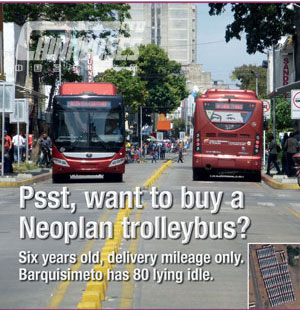Civic inefficiency; trolleybuses parked
2014-09-28 Source:
Summarize:Welcome to Barquisimeto, the Venezuelan city whose trolleybus-based bus rapid transit service makes Edinburgh’s tram fiasco look like a model of civic efficiency. They ought to be twinned cities, on the grounds of sharing the ability to make transport cock-ups on a monumental scale.
www.chinabuses.org: Welcome to Barquisimeto, the Venezuelan city whose trolleybus-based bus rapid transit service makes Edinburgh’s tram fiasco look like a model of civic efficiency. They ought to be twinned cities, on the grounds of sharing the ability to make transport cock-ups on a monumental scale.

In 2006 Barquisimeto ordered 80 Neoplan N6321 articulated trolleybuses. They were delivered in 2007-08.
To support the new service, Transbarca, the city built a busway in the centre of one of its busiest trunk roads. It was largely completed in 2007, with overhead wiring in place for much of its length. At the same time major roadworks in the central area saw improvements to the streetscape, with dedicated bus lanes and new pavements. Transbarca was coming, providing a significant upgrade for public transport users in this city of one million people.
Two trunk routes were developed, running east-west through the city, and both using the segregated busway for about half of their length. Both are about ten miles long. In 2012 a trolleybus was tested on the busway. Then the project got de-wired. The Transbarca website was taken down. The trolleybuses disappeared from view.
The service finally started late last year, but not using the fleet of expensive Neoplan articulated trolleybuses. Underneath the overhead wires, Transbarca is now running 130 CNG-powered Yutongs.
The Yutongs are 12m models with a two-step entrance, ZK6118HGA in the catchy nomenclature the Chinese use to identify bus types. Passengers pay using smartcards. The drivers do not handle cash. The busway section of the route has central island platforms, meaning that the buses run in what amounts to the wrong way, driving in the left lane. In the city centre there are stretches of bus-only roads and a contra-flow bus lane, but vehicles are still delayed by the heavy traffic which characterises most Venezuelan cities. This particularly affects the six feeder services which connect with the two trunk routes.
On the two main routes buses were usually well-loaded, but the service was also irregular. At most stops the service was delayed by drivers waiting until alighting passengers had got off through the centre doors before opening the front doors for boarding passengers. A button on the driver’s control panel allows him or her to broadcast a message telling standing passengers to move up the bus. It gets a lot of use.
There are dedicated seats for elderly, disabled and pregnant passengers, marked by blue instead of yellow seat frames. Another broadcast message tells passengers to give up these seats if they are needed by a disabled traveller. The buses are equipped with CCTV and air-conditioning, the latter an important feature in a city where the temperature is typically around 30degC.
Barquisimeto is not alone in getting upgraded public transport. Yutong buses are being used to improve services in a number of Venezuelan towns and cities, and by the middle of next year there should be approaching 3,000 in service in the country.
Views:0Editor:
Related China Bus News
